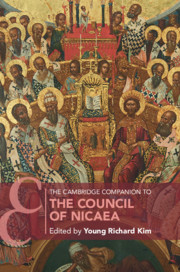Book contents
- The Cambridge Companion to the Council of Nicaea
- Cambridge Companions to Religion
- The Cambridge Companion to the Council of Nicaea
- Copyright page
- Dedication
- Contents
- Figures
- Contributors
- Acknowledgements
- Abbreviations
- 1 Introduction
- Part I Contexts
- Part II The Council
- Part III Outcomes
- 7 The Creed
- 8 The Twenty Canons of the Council of Nicaea
- 9 The Council of Nicaea and the Celebration of the Christian Pasch
- 10 Narrating the Council
- Part IV The Aftermath
- Part V The Long Reception
- Appendices
- Bibliography
- Index
- References
9 - The Council of Nicaea and the Celebration of the Christian Pasch
from Part III - Outcomes
Published online by Cambridge University Press: 17 December 2020
- The Cambridge Companion to the Council of Nicaea
- Cambridge Companions to Religion
- The Cambridge Companion to the Council of Nicaea
- Copyright page
- Dedication
- Contents
- Figures
- Contributors
- Acknowledgements
- Abbreviations
- 1 Introduction
- Part I Contexts
- Part II The Council
- Part III Outcomes
- 7 The Creed
- 8 The Twenty Canons of the Council of Nicaea
- 9 The Council of Nicaea and the Celebration of the Christian Pasch
- 10 Narrating the Council
- Part IV The Aftermath
- Part V The Long Reception
- Appendices
- Bibliography
- Index
- References
Summary
In 525 Dionysius Exiguus compiled his 95-year continuation of the Alexandrian Paschal table, which eventually scheduled the celebration of Pasch for the entire western Church. He also stated that the Council of Nicaea had authorized the 19-year Alexandrian Paschal cycle and that this had been maintained by subsequent Alexandrian bishops. These statements were challenged by Jan in 1718, and since then the question of Nicaean authority has been disputed. However, while the Synoptic Gospels agree that the Crucifixion took place on the day after the Jewish Passover, John’s Gospel places it on the day of the Passover and hence on the fourteenth day of the spring moon. Thus the Evangelistic accounts of Jesus’s Crucifixion conflict chronologically. Consequently, the Asian churches chose to emphasize the Crucifixion by celebrating Pasch on the fourteenth day of the moon, while other churches emphasized the Resurrection by celebrating it on Sunday. At Nicaea Constantine sought to resolve this conflict, and contemporaneous accounts agree that the Council decreed that Pasch be celebrated only on Sunday, and forbade celebration on the fourteenth day. This chapter concludes that the origin of the Alexandrian Paschal table lies rather with bishop Theophilus in the last decades of the fourth century.
Keywords
- Type
- Chapter
- Information
- The Cambridge Companion to the Council of Nicaea , pp. 177 - 201Publisher: Cambridge University PressPrint publication year: 2021



